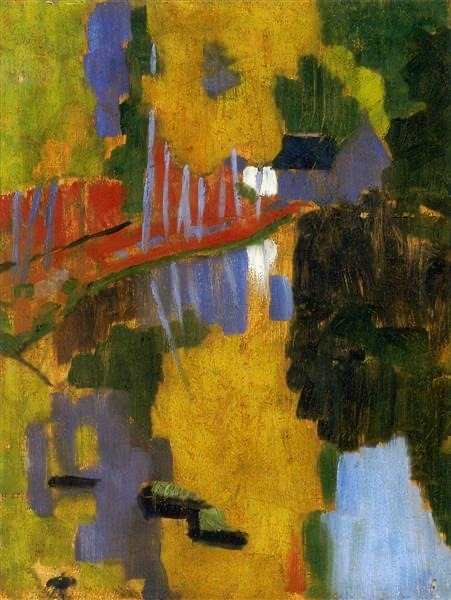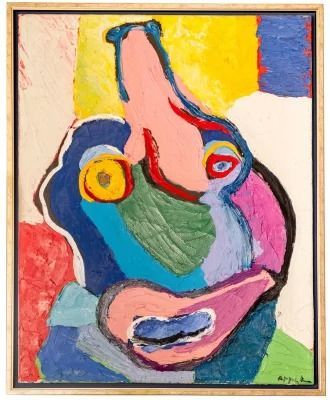Sonia Delaunay

Sonia Delaunay
Rythme coloré, January 26, 1936
Gouache on paper
More Posts from Art0634 and Others

Mernet Larsen
Reading in Bed, 2015

Fernand Léger, Le buste, Painted in 1925
oil on canvas
65 by 50cm. - 25 5/8 by 19 5/8 in.

Ameisenhaufen
Artist: Marianne von Werefkin (Russian, 1860–1938)
Style: German Expressionism
Date: c. 1916
Medium: Oil and tempera on paper laid down on board
Collection: Private collection
Description
Marianne von Werefkin was one of the most remarkable women working at the centre of Munich’s avant-garde circle during a period of rapid change and intense creativity at the turn of the twentieth century. Born in the Russian town of Tula near Moscow in 1860, she studied art under the private tutelage of Ilya Repin. It was there that she met Alexej von Jawlensky in 1891, with whom her relationship as mentor, patron and companion would last until 1921. The couple moved to Munich in 1896, at which point Werefkin gave up painting for almost a decade in order to devote herself entirely to the development and promotion of Jawlensky’s talents. During this time, however, she played a decisive role in the Munich art scene as hostess of a salon on Giselastrasse, where she commanded the room of artists, writers, dancers, progressive thinkers and Russian émigrés who were attracted there.
After almost twelve months touring France with Jawlensky, Werefkin returned to painting in early 1907. The couple formed a close friendship with Wassily Kandinsky and Gabriele Münter, which led to the founding of a secessionist group called the Neue Künstlervereinigung München (New Association of Artists in Munich, NKVM) in 1909. The group’s spiritualist principles were founded on a desire to synthesise the impressions projected on the artist by the external world and the personal experience of this collected by the artist. The NVKM paved the way for the Blaue Reiter group, which would be created in 1911 in rejection of the former group by renegade members. Marianne von Werefkin, adhering artistically to Symbolism whilst belonging to the inner circle of the developing group, was the only artist close to the Blaue Reiter circle whose work focused on social issues and the world of human labour and factory work, and her figurative work became her defining point.

Paul Serusier
The Talisman: The Aven River at the Bois d'Amour
1888

KAREL APPEL

Richard Diebenkorn, Berkeley #59, 1953

Untitled
2025
Noak Esbjörnsson

Albert Gleizes
Equistrienne (1916)

Painting - Jarda
Painting on paper,
acryl, pencil, pen and wax crayon,
high gloss varnish,
mixed media, 40 x 47 cm
-
 vulgar-and-chic liked this · 1 month ago
vulgar-and-chic liked this · 1 month ago -
 carolinabluemoon liked this · 1 month ago
carolinabluemoon liked this · 1 month ago -
 spazz981 liked this · 1 month ago
spazz981 liked this · 1 month ago -
 mazi-yaar liked this · 1 month ago
mazi-yaar liked this · 1 month ago -
 vangoghanddaisies reblogged this · 1 month ago
vangoghanddaisies reblogged this · 1 month ago -
 icareaboutyou liked this · 1 month ago
icareaboutyou liked this · 1 month ago -
 hootenanie liked this · 1 month ago
hootenanie liked this · 1 month ago -
 in-kind reblogged this · 1 month ago
in-kind reblogged this · 1 month ago -
 vanityunfair reblogged this · 1 month ago
vanityunfair reblogged this · 1 month ago -
 yes-gigging-posts liked this · 3 months ago
yes-gigging-posts liked this · 3 months ago -
 onmyowntwohands liked this · 3 months ago
onmyowntwohands liked this · 3 months ago -
 delicas-world liked this · 3 months ago
delicas-world liked this · 3 months ago -
 iamniscalo liked this · 7 months ago
iamniscalo liked this · 7 months ago -
 luca16 liked this · 8 months ago
luca16 liked this · 8 months ago -
 baddisneypuppy reblogged this · 9 months ago
baddisneypuppy reblogged this · 9 months ago -
 baddisneypuppy liked this · 9 months ago
baddisneypuppy liked this · 9 months ago -
 mermanonfire reblogged this · 9 months ago
mermanonfire reblogged this · 9 months ago -
 lomelino reblogged this · 11 months ago
lomelino reblogged this · 11 months ago -
 accrochage reblogged this · 11 months ago
accrochage reblogged this · 11 months ago -
 neuvogue reblogged this · 11 months ago
neuvogue reblogged this · 11 months ago -
 omcgowan reblogged this · 1 year ago
omcgowan reblogged this · 1 year ago -
 com-pose-prop-osit-i-on reblogged this · 1 year ago
com-pose-prop-osit-i-on reblogged this · 1 year ago -
 antibacterialthesis liked this · 1 year ago
antibacterialthesis liked this · 1 year ago -
 thom-57 liked this · 1 year ago
thom-57 liked this · 1 year ago -
 heartattackkidd reblogged this · 1 year ago
heartattackkidd reblogged this · 1 year ago -
 rumforall liked this · 1 year ago
rumforall liked this · 1 year ago -
 no-other-thrill reblogged this · 1 year ago
no-other-thrill reblogged this · 1 year ago -
 kitcom liked this · 1 year ago
kitcom liked this · 1 year ago -
 foolingthesilence reblogged this · 1 year ago
foolingthesilence reblogged this · 1 year ago -
 rivrthx reblogged this · 1 year ago
rivrthx reblogged this · 1 year ago -
 eccentricks reblogged this · 1 year ago
eccentricks reblogged this · 1 year ago -
 eccentricks liked this · 1 year ago
eccentricks liked this · 1 year ago -
 my-morning-nausea liked this · 1 year ago
my-morning-nausea liked this · 1 year ago -
 halluzinocat liked this · 1 year ago
halluzinocat liked this · 1 year ago -
 lisodah liked this · 1 year ago
lisodah liked this · 1 year ago -
 entscheidungsproblem-blog liked this · 1 year ago
entscheidungsproblem-blog liked this · 1 year ago -
 subnitida liked this · 1 year ago
subnitida liked this · 1 year ago -
 omcgowan reblogged this · 1 year ago
omcgowan reblogged this · 1 year ago -
 jcsnyc3 liked this · 1 year ago
jcsnyc3 liked this · 1 year ago -
 frankdriscoll liked this · 1 year ago
frankdriscoll liked this · 1 year ago -
 autodidactadelavida liked this · 1 year ago
autodidactadelavida liked this · 1 year ago -
 footsack1 reblogged this · 1 year ago
footsack1 reblogged this · 1 year ago -
 nightdanger reblogged this · 1 year ago
nightdanger reblogged this · 1 year ago -
 thearspoetica reblogged this · 1 year ago
thearspoetica reblogged this · 1 year ago -
 thearspoetica liked this · 1 year ago
thearspoetica liked this · 1 year ago -
 art0634 reblogged this · 1 year ago
art0634 reblogged this · 1 year ago -
 art0634 liked this · 1 year ago
art0634 liked this · 1 year ago -
 pothosbonez liked this · 1 year ago
pothosbonez liked this · 1 year ago